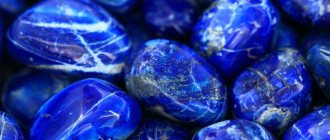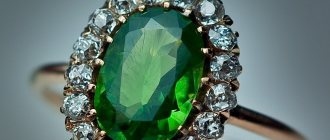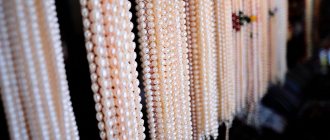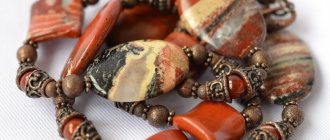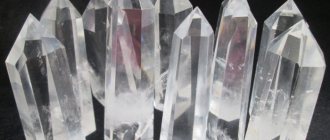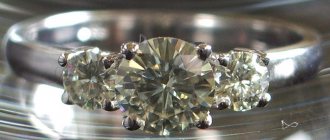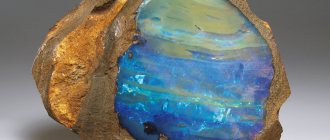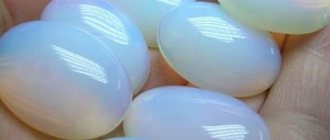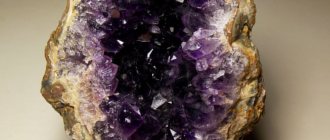Olivine is a stone that can be found on Earth and in space. It is the most common mineral in the Earth's mantle; it forms the basis of lunar soil and is often found in meteorites. A variety of olivine is the precious chrysolite.
History and origin of the name
The name “olivine” was given to the mineral in 1789 by the German geologist Abraham-Gottlob Werner for the similarity of green glass-like inclusions he discovered in basalts with olives, the fruit of the olive tree. Interestingly, 42 years before him, the same stone was described by the Swedish naturalist Vallerius. But Werner was included in the encyclopedia.
An even earlier description can be found in Pliny the Elder, who, back in the 1st century AD, described transparent green stones falling from the sky. For a long time, scholars debated what Pliny meant until meteorites called palassites, consisting of iron, nickel and olivine, were found.
Interesting: The Hayabusa space probe delivered soil from the Itokawa asteroid. 39% of it was olivine. It has been discovered on Mars and in the tails of comets.
The ancient Egyptians mined olivine on the island of Zabargad in the Red Sea, and then it was distributed throughout the ancient world. In the Bible it is mentioned several times under the name “peridot”. This stone is mentioned among the 12 stones of the high priest Aaron.
In Hebrew, the name sounds like “tarshish”, and “peridot” is a Greek word that can be translated as “golden stone”. Olivine has another name: “peridot” from “peridona” - “giving abundance”. Now this name is accepted as a synonym for olivine, and chrysolite is the name given to its precious green variety.
Nero's huge monocle was made from chrysolite, through which he watched gladiator fights and admired the burning of Rome.
Interesting: Olivine is the main mineral of the earth’s mantle to a depth of 400 km; it reaches the surface during volcanic eruptions.
On the Hawaiian Islands you can find beaches with sand and pebbles consisting of olivine, which the Hawaiians call the tears of the goddess.
Olivine came to medieval Europe with the crusaders who captured Egyptian mines on the island of Zabargad. It is interesting that olivine is still mined there; it turns out that this mine has not been depleted for several millennia.
Crystallographic characteristics
Rhombic syngony Rhombo-bipyramidal class. D2h—mmm (3L23PC).
Form of being in nature
Continuous fine-grained masses. Ural
The appearance of crystals.
Crystals of various shapes are mostly short-prismatic, elongated along the c axis, often tabular along 6(010), rarely along a(100). Sometimes the crystals are elongated along the a-axis; An unusual elongation according to [101] was noted for olivine crystals forming inclusions in diamond (accordingly, they have an oblique extinction). Crystals of pseudohexagonal development are observed. Kalb and Koch identified three types of crystals:
1) “Sasbach type”, characteristic of phenocrysts in basic rocks;
2) “Monzoni type” - in contact-metamorphic formations;
3) “Triblitz type” - the latest crystals of pneumatolytic origin (mainly fayalite);
These types, however, do not exhaust the variety of olivine crystals found in nature. In meteorites - pallasites, the crystals of the mineral are round. Skeletal crystals are quite common. Skeletal development is also characteristic of olivine crystals in slags. Vertical hatching is often observed on the a (100) faces. On the surface of olivine crystals from Yakut kimberlites, peculiar pyramids, cone-shaped mounds and ribbed surfaces were noted, interpreted as figures of partial dissolution.
Twins according to (011) and according to (031) are common; they are twins of germination; they are relatively rare; even less often - tees; Twins at (012), at (120) and at (110) were also noted. According to Burri, twins are predominantly observed in olivine crystals from rocks enriched in calcium (ancaratrites, melilite basalts, etc.). Twins are found relatively more often in slag olivine: in synthetic fayalite, only (011) twins were observed.
Aggregates. Olivine usually occurs in the form of granular masses or individual grains included in the rock.
Place of Birth
Olivine is one of the main rock-forming minerals, so its deposits can be found everywhere. In Russia, there are large deposits in Buryatia, the Krasnoyarsk Territory, Yakutia, the Amur Region and the Kola Peninsula.
The largest deposits are located in the USA, India, Mexico, Norway, Australia, and Kenya.
It is also mined in Afghanistan, Italy and many other countries. Tourists visiting the Canary Islands are sure to buy olivine beads.
Chemical properties and composition
Olivine is a silicate of magnesium and iron, often also containing nickel, calcium, cobalt, manganese and chromium. The more iron there is in it, the more intense the color. Manganese, nickel, cobalt and chromium give different shades to the transparent stone.
Chemical formula – (MgFe)2[SiO4]
Rules of care
Olivine does not require special care because it does not fade in the sun, does not scratch or split from falling. However, you must follow the general recommendations for caring for jewelry:
- store in a separate box with soft walls. The insert itself will not suffer from proximity to stones, but the frame of the product may be scratched;
- When washing or washing, jewelry with stones is removed, otherwise there will be a soapy residue on it that is difficult to wash out;
- protect from falls. Olivine is difficult to crack. but this does not mean that it is not possible;
- protect from exposure to household chemicals. This will make the stone dull and ruin the setting;
- Clean in running water and wipe dry with a soft cloth. You can also use special compounds or contact a jeweler.
Olivine usually lasts a long time and does not cause any trouble, either in household or energy terms.
Varieties
Olivine is a mineral that has many varieties, representing a whole family of minerals that differ in composition and color.
If it lacks iron, it is a magnesium silicate called forsterite Mg2SiO4. It comes in white, grey, pale yellow or green. It has the lowest density among olivines -3.275 g/cm3 and the highest hardness -7.
If there is no magnesium in olivine, then it is an iron silicate called fayalite Fe2SiO4. Its color can be brown, yellow and black, and its density is noticeably higher than that of other olivines - 4.39 g/cm3, and its hardness, on the contrary, is less than -6.5.
These two minerals are extreme members of the isomorphic forsterite-fayalite series.
Magnesium in forsterite can be replaced by calcium, and a continuous isomorphic series of forsterite-calcio-olivine Ca2SiO4 is also formed. The middle member of the CaMgSiO4 series has its own name monticellite.
If calcium in olivine is completely replaced by calcium, then such a mineral is called kirnsteinite (CaFe)2[SiO4].
Iron in it can also be replaced by manganese, resulting in glaucochroite (CaMn)2[SiO4].
When iron in olivine is completely replaced by nickel, libenbergite (NiMg)2[SiO4] is obtained.
Finally, there is the olivine mineral, which contains zinc. This is rupperite (FeMnZn)[SiO4].
Transparent, gem-quality olivine with a color ranging from greenish-yellow to emerald green is called peridot. This is what the Egyptians valued so much 5000 years ago.
Serpentine or serpentine ornamental stone is also olivine that has been exposed to water. It belongs to the group of magnesium-iron hydrosilicates, numbering about 20 minerals that have their own names.
The difference between a real stone and a fake and compatibility with other minerals
Olivine differs from other stones in the amount of birefringence. A faceted crystal has a strongly pronounced edge doubling effect. By passing a light beam through a stone, you can get two beams. To see this phenomenon, you need to twirl the stone in your hands.
Natural olivine can easily be confused with another gem - chrysoberyl. The difference between a gem is its density. In chrysolite it is smaller.
Painted glass is often used for counterfeiting. A distinctive feature of a real crystal is its uniform color. Colored seals and various thickenings indicate a fake. Plastic imitation is revealed very easily - it can be easily scratched.
Energetically, olivine cannot be combined with all minerals:
- the ideal combination is obtained with turquoise, agate, emerald, pearls;
- a combination with topaz is considered a neutral option;
- contradictory relationships are observed with red garnets, quartz, moonstone and aquamarine;
- the mineral does not combine with malachite, obsidian, or onyx at all.
Olivine goes well with turquoise.
Magic properties
Olivine is a talisman for magicians, healers, astrologers, scientists, musicians, athletes, lawyers, judges and businessmen. This wealth of magical properties is explained by the fact that it combines divine and earthly love and belongs to the heart chakra, from which favorable energies reach all organs.
In addition to connecting with other worlds, developing intuition and the will to win, olivine gives an ear for music, eloquence, the ability to find the right solution and convincing words. It will help you achieve harmony in your relationships with your spouse, children, parents, friends and partners. Olivine will protect the house from fire, and the owners from damage and the evil eye.
If spouses wear identical olivine rings, they will live in harmony for many years.
Compatibility with zodiac signs
Astrologers have long been studying the compatibility of the mineral with zodiac signs. The experts concluded that:
- The energetic power of the mineral is suitable for Virgos. People will be directed to the true path, they will be able to develop and improve themselves. Under the influence of the stone, Virgos will accumulate the necessary skills and establish relationships with others. Representatives of this sign will be able to build romantic relationships.
- The stone is also suitable for Pisces, helps in increasing self-esteem, and gets rid of complexes. Under the influence of the mineral, Pisces learn to make decisions and cope with life's difficulties. Representatives of this sign will learn to defend their point of view.
- Olivine suits Leo. The gem develops leadership qualities and helps in achieving success. Leos learn to avoid conflicts and problems.
- It is better for Capricorns not to use the power of the mineral, since their energy will conflict.
Medicinal properties
Olivine has the following medicinal properties:
- eliminates depression and anxiety;
- normalize blood pressure;
- improves sleep;
- restores vision;
- heals heart disease and protects against heart attack;
- protects against infections;
- helps during childbirth, making it painless.
A surge of interest in olivine in the 19th century was fueled by reports that it was a powerful aphrodisiac and cured impotence.
Chrysolite for healing ailments
The magical properties of the chrysolite stone are not limited to attracting good luck into the life of its owner. These green gems have a powerful healing gift. Lithotherapists (adherents of the practice of treating diseases with the help of stones) actively use peridots to combat many ailments.
The areas of application of the “evening emerald” in lithotherapy are truly diverse:
- Treatment of eye diseases - just look at the stone for a long time.
- Healing from cardiovascular and endocrine diseases.
- Relief of fever symptoms.
- Rescue from insomnia and nightmares;
- Getting rid of stuttering by constantly wearing jewelry with peridots.
- Acceleration of the recovery period after serious illnesses.
- Relieving pain, for example, during migraines, inflammation in the stomach, kidneys, liver, spine. In addition, it is believed that the stone helps women in labor endure contractions more easily.
Lithotherapists often use chrysolite powder to improve the overall health of the body and cleanse it of toxins. Based on this powder, adherents of alternative medicine prepare ointments for the treatment of skin diseases.
Products with olivine
Translucent and transparent olivines of jewelry quality are used to make rings, pendants, brooches, beads and bracelets.
Large stones become a desirable prey for collectors.
You can fall in love with olivine at first sight, even from a photo. This beautiful stone will become your faithful talisman.
Areas of use
Rock with a low percentage of iron is used in metallurgy in the manufacture of refractory bricks for the construction of blast furnaces, open-hearth furnaces and accessories for them, and with a higher proportion of magnesium it is used for the production of technical glass and special viscous grades of cement.
The main use of olivine is jewelry.

